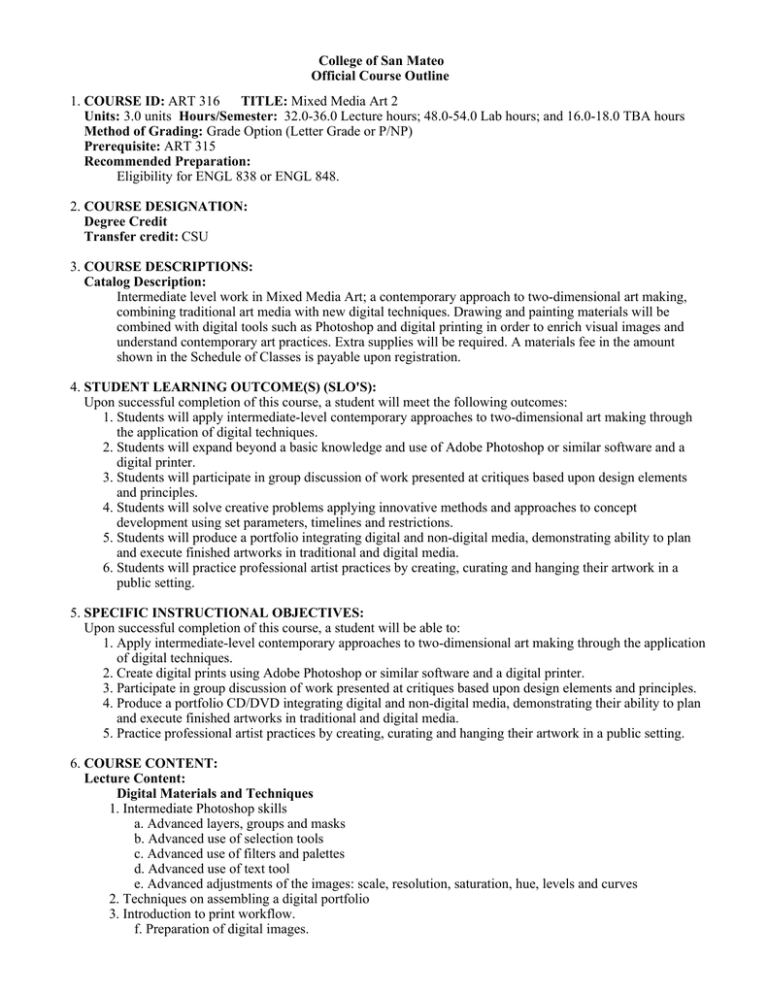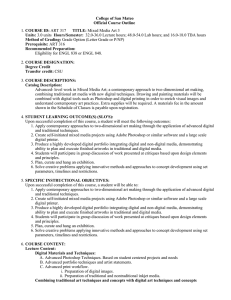College of San Mateo Official Course Outline COURSE ID: Units:
advertisement

College of San Mateo Official Course Outline 1. COURSE ID: ART 316 TITLE: Mixed Media Art 2 Units: 3.0 units Hours/Semester: 32.0-36.0 Lecture hours; 48.0-54.0 Lab hours; and 16.0-18.0 TBA hours Method of Grading: Grade Option (Letter Grade or P/NP) Prerequisite: ART 315 Recommended Preparation: Eligibility for ENGL 838 or ENGL 848. 2. COURSE DESIGNATION: Degree Credit Transfer credit: CSU 3. COURSE DESCRIPTIONS: Catalog Description: Intermediate level work in Mixed Media Art; a contemporary approach to two-dimensional art making, combining traditional art media with new digital techniques. Drawing and painting materials will be combined with digital tools such as Photoshop and digital printing in order to enrich visual images and understand contemporary art practices. Extra supplies will be required. A materials fee in the amount shown in the Schedule of Classes is payable upon registration. 4. STUDENT LEARNING OUTCOME(S) (SLO'S): Upon successful completion of this course, a student will meet the following outcomes: 1. Students will apply intermediate-level contemporary approaches to two-dimensional art making through the application of digital techniques. 2. Students will expand beyond a basic knowledge and use of Adobe Photoshop or similar software and a digital printer. 3. Students will participate in group discussion of work presented at critiques based upon design elements and principles. 4. Students will solve creative problems applying innovative methods and approaches to concept development using set parameters, timelines and restrictions. 5. Students will produce a portfolio integrating digital and non-digital media, demonstrating ability to plan and execute finished artworks in traditional and digital media. 6. Students will practice professional artist practices by creating, curating and hanging their artwork in a public setting. 5. SPECIFIC INSTRUCTIONAL OBJECTIVES: Upon successful completion of this course, a student will be able to: 1. Apply intermediate-level contemporary approaches to two-dimensional art making through the application of digital techniques. 2. Create digital prints using Adobe Photoshop or similar software and a digital printer. 3. Participate in group discussion of work presented at critiques based upon design elements and principles. 4. Produce a portfolio CD/DVD integrating digital and non-digital media, demonstrating their ability to plan and execute finished artworks in traditional and digital media. 5. Practice professional artist practices by creating, curating and hanging their artwork in a public setting. 6. COURSE CONTENT: Lecture Content: Digital Materials and Techniques 1. Intermediate Photoshop skills a. Advanced layers, groups and masks b. Advanced use of selection tools c. Advanced use of filters and palettes d. Advanced use of text tool e. Advanced adjustments of the images: scale, resolution, saturation, hue, levels and curves 2. Techniques on assembling a digital portfolio 3. Introduction to print workflow. f. Preparation of digital images. g. Preparation of traditional and nontraditional inkjet media. g. Preparation of traditional and nontraditional inkjet media. 4. Intermediate use of digital tablet Combining traditional art techniques and concepts with digital art techniques and concepts: a. Using scanned drawings and paintings to create composites and versions b. Using digital printouts as ground for drawing, painting and collage c. Techniques in combining traditional drawing and painting and mixed media with digital media. d. Formal design elements explored and contrasted in both digital and traditional art Contemporary Contexts: a. Examples shown of contemporary digital art (multimedia lectures)-Leading to research projects b. Researching web-based art communities, galleries and local organizations that support digital artists. Intermediate Symbolic Process: An in-depth theoretical and experiential study of symbols including various approaches to representation, identity and branding. Students will research various historical / contemporary symbols and create an artwork based on their research. Create a portfolio of images combining traditional and digital strategies, concepts and techniques: Result is a digital presentation of a professional portfolio. Developing Image Bank: Students will develop a collection of resources and materials from images collected on the web and various other printed sources as well as from their own work. Students will scan and file their artwork for use in digital art projects. Working with Street Art and Transfer techniques: Students will learn to draw, cut and paint with stencils using digital and traditional techniques. Students will learn multiple techniques for using digital transfers. Lab Content: Course lab content are projects and assignments based upon the material and information presented in the course lecture content. TBA Hours Content: Students fulfill the required To be Arranged hours with the following suggested activities which take place in the art studios at CSM under the art instructor's supervision: 1. Directed projects to design specific types of mixed media images, subjects, compositional techniques, or other artistic objectives. 2. Directed technical exercises to improve mixed media skills, techniques and use of materials. 3. Critique and evaluation of mixed media assignments and exercises. 4. Collaborative projects with other students to investigate artistic endeavors using various media. 5. Any other mixed media projects approved by the instructor. 7. REPRESENTATIVE METHODS OF INSTRUCTION: Typical methods of instruction may include: A. Lecture B. Lab C. Activity D. Critique E. Directed Study F. Discussion G. Experiments H. Field Trips I. Individualized Instruction J. Observation and Demonstration 8. REPRESENTATIVE ASSIGNMENTS Representative assignments in this course may include, but are not limited to the following: Writing Assignments: Writing and Critical Thinking-students will be required to: 1. Self-evaluate their process of creating one art project. 2. Answer and analyze questions about class field trips. 3. Research and present material about artists in the field of Digital art and Mixed-Media Reading Assignments: 1. Multimedia lectures supported by handouts. 2. Reading from the representative texts; “Digital Alchemy” and “The Last Layer” by Bonnie Pierce Lhotka. Other Outside Assignments: 1. Field trips to museums, exhibitions and artist studios. 2. Interviews with artists in a related artistic field of interest to further develop a project. To be Arranged Assignments: Students fulfill the required To be Arranged hours with the following suggested activities which take place in the art studios at CSM under the art instructor's supervision: 1. Directed projects to design specific types of mixed media images, subjects, compositional techniques, or other artistic objectives. 2. Directed technical exercises to improve mixed media skills, techniques and use of materials. 3. Critique and evaluation of mixed media assignments and exercises. 4. Collaborative projects with other students to investigate artistic endeavors using various media. 5. Any other mixed media projects approved by the instructor. 9. REPRESENTATIVE METHODS OF EVALUATION Representative methods of evaluation may include: A. Class Participation B. Class Work C. Exams/Tests D. Field Trips E. Group Projects F. Homework G. Lab Activities H. Oral Presentation I. Papers J. Portfolios K. Projects L. Quizzes M. A. Completion of all Assignments. 1. Creation of digital image bank on a CD/DVD or portable drive. 2. Creation of Digital Sketchbook, portfolio, on a CD/DVD of works produced throughout the semester. 3. Traditional sketch book. 4. Homework assignments to practice and refine skills using materials and techniques learned in class. 5. Completion and presentation of studio art projects. 6. Timely completion of writing assignments. 7. Final presentation and critique of Digital Sketchbook portfolio. B. Active participation in class discussion and critiques. C. Student must demonstrate growth in creative uses of materials and techniques from initial level of ability at the outset of the semester to end of the semester. This will be determined through the classwork, homework, studio art assignments and the final Digital Sketchbook. Student must demonstrate a willingness to experiment with materials and techniques and a developing ability to propose individual solutions to creative challenges. D. Student must demonstrate ability to integrate traditional and digital media and name and recall basic techniques in Adobe Photoshop. 10. REPRESENTATIVE TEXT(S): Possible textbooks include: A. Pierce Lhotka, B.. The Last Layer; New methods in digital printing for photography, fine art, and mixed media (Voices That Matter) , 1st ed. Indianapolis: New Riders, 2013 B. Pierce Lhotka, B.. Digital Alchemy: Printmaking techniques for fine art, photography, and mixed media (Voices That Matter), 1st ed. Indianapolis: New Riders, 2010 Origination Date: March 2014 Curriculum Committee Approval Date: October 2014 Effective Term: Fall 2015 Course Originator: Rebecca Alex


